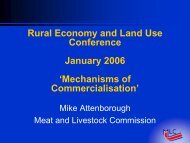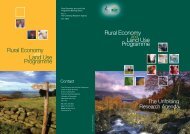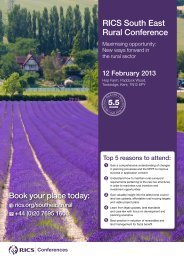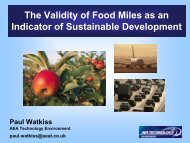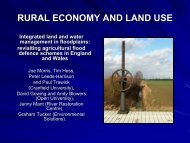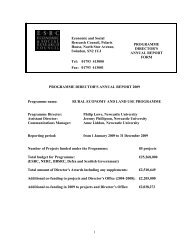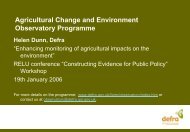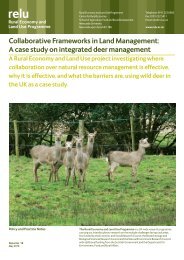Future Society in 2024: 21st Century 'Good Life' - Rural Economy ...
Future Society in 2024: 21st Century 'Good Life' - Rural Economy ...
Future Society in 2024: 21st Century 'Good Life' - Rural Economy ...
Create successful ePaper yourself
Turn your PDF publications into a flip-book with our unique Google optimized e-Paper software.
Economic: Transient rural areas face grave economic difficulties. We have identified the ma<strong>in</strong><br />
growth prospects for rural areas <strong>in</strong> the com<strong>in</strong>g 20 years to lie <strong>in</strong> tourism, leisure services, rural<br />
enterprise, retirement services and positive multiplier effects aris<strong>in</strong>g from affluent <strong>in</strong>-migration.<br />
Transient rural areas face poor projections on all these counts.<br />
Social: The socio-economic structure of transient rural areas is particularly adversely affected by the<br />
process of rural de-<strong>in</strong>dustrialisation that is presently tak<strong>in</strong>g place. As stated transient rural areas<br />
will cont<strong>in</strong>ue to face difficulties with respect to social exclusion <strong>in</strong> future years.<br />
Technological: Technological changes will neither br<strong>in</strong>g rapid improvement to transient rural areas,<br />
nor will it <strong>in</strong>deed affect them <strong>in</strong> any major way. Transient rural areas fare extremely badly on all the<br />
<strong>in</strong>dicators of ICT take-up, with the sole exception of age (transient rural populations tend to be of<br />
work<strong>in</strong>g age). They are likely to cont<strong>in</strong>ue to have poor <strong>in</strong>frastructure and this will deter what few<br />
rural entrepreneurs they might otherwise have succeeded <strong>in</strong> attract<strong>in</strong>g.<br />
D. ‘Deep rural’<br />
Overview<br />
In the more scenic areas, the ‘farmer’ owns a few sheep and a sheep dog for ‘ma<strong>in</strong>ta<strong>in</strong><strong>in</strong>g’ the<br />
countryside – keep<strong>in</strong>g the grass down. For this he gets a subsidy from Europe or central government<br />
because there is value <strong>in</strong> cared for uplands. However, the rest of the time he is work<strong>in</strong>g for the<br />
professional couple that now live (for most of the week) nearby. His wife runs a B&B.<br />
The professional couple nearby regard the area as their ‘home’ but there ‘<strong>in</strong>tellectual and economic’<br />
base is still the city, and they ma<strong>in</strong>ta<strong>in</strong> a second home there where they use their time to socialize<br />
with friends and colleagues. There is no longer a clear dist<strong>in</strong>ction between the work<strong>in</strong>g week and<br />
the weekend. Rather, their week is structured by time <strong>in</strong> the country and time <strong>in</strong> the city and they<br />
work for about two thirds of every day (<strong>in</strong>ternationally). Dur<strong>in</strong>g the summer they spend more time <strong>in</strong><br />
the country and less <strong>in</strong> the city (they have an outdoor swimm<strong>in</strong>g pool and a separate (up-market)<br />
self cater<strong>in</strong>g annex for hous<strong>in</strong>g pay<strong>in</strong>g guests as well as friends and family). Dur<strong>in</strong>g the w<strong>in</strong>ter, they<br />
spend more time <strong>in</strong> the city. Their children are at board<strong>in</strong>g school.<br />
Dur<strong>in</strong>g the summer, the area is busy with tourists, who stay <strong>in</strong> Germanic log cab<strong>in</strong>s. The area is<br />
much quieter <strong>in</strong> w<strong>in</strong>ter. The National Trust has bought up one or two farms <strong>in</strong> the area, which are<br />
very popular with the tourists.<br />
The area is very dependent on the wealth of city based people. There is still no ethnic diversity <strong>in</strong><br />
the area – it is still very much white Anglo-Saxon.<br />
The less scenic areas have been taken over by w<strong>in</strong>d farms, and factory farm<strong>in</strong>g/poly tunnels for<br />
cont<strong>in</strong>uous food production.<br />
The key drivers that have affected the lives of the people described above are: IT, economic growth,<br />
farm<strong>in</strong>g supports and the plann<strong>in</strong>g system.<br />
Key Trends<br />
Political: Over a twenty-year time frame, deep rural areas are unlikely to be affected by many of the<br />
salient political changes that we might foresee (e.g. regional devolution). A looser plann<strong>in</strong>g policy<br />
will aid <strong>in</strong>-migration to these areas; however local political pressures to restrict new development are<br />
weakened by the relative absence of politically active groups <strong>in</strong> these areas.<br />
72



